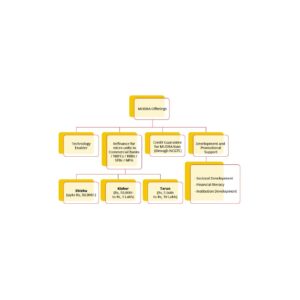![]()
MudraLoan in India
MudraLoan in India function as a means of offering financial assistance to small businesses and entrepreneurs through a range of financial institutions.
Overview of how mudra loan work in India:
1. Loan Categories:
MUDRA loans are divided into three categories based on the stage and funding needs of the business:
a. Shishu: This category offers loans up to Rs. 50,000 for businesses in the initial stage. It targets startups and small businesses that require a small amount of capital to start their operations.
b. Kishore: Kishore loans range from Rs. 50,000 to Rs. 5 lakh and are designed for established businesses looking for additional funds to expand their operations or meet working capital requirements.
c. Tarun: Tarun loans range from Rs. 5 lakh to Rs. 10 lakh and cater to businesses seeking higher amounts of funds for expansion, diversification, or other business purposes.
2. Eligibility:
Individuals, small businesses, and enterprises engaged in various sectors such as manufacturing, trading, services, and agriculture are eligible to apply for MUDRA loans.
Both new and existing businesses can avail of these loans, subject to meeting the specific eligibility criteria set by the lending institutions.
3. Lending Institutions:
Mudra loan is offered through registered financial institutions such as banks, Non-Banking Financial Companies (NBFCs), and Micro Finance Institutions (MFIs).
These institutions act as intermediaries between the borrowers and MUDRA and facilitate the loan disbursal process.
4. Application Process:
To apply for a MUDRA loan, individuals or businesses need to approach the participating financial institutions.
The application process typically involves submitting relevant documents, including business plans, financial statements, KYC (Know Your Customer) documents, and other required information.
The lending institution assesses the loan application based on these documents and the borrower’s creditworthiness.
5. Loan Disbursal:
Once the loan application approved, the lending institution disburses the loan amount to the borrower’s bank account.
The loan can be use for various purposes such as working capital, purchasing machinery or equipment, renovating premises, or meeting other business-related expenses.
6. Repayment:
MUDRA loans come with flexible repayment terms.
Borrowers can choose a suitable repayment schedule based on their business cash flows.
The repayment period can range from a few months to several years, depending on the loan amount and the borrower’s preference.
The loan is typically repaid through EMIs (Equated Monthly Installments).
7. Interest Rates:
The interest rates for MUDRA loans can vary among different lending institutions.
The rates are generally competitive and affordable for small businesses and startups.
The lending institution determines the interest rate based on factors such as the loan category, loan amount, borrower’s credit profile, and prevailing market conditions.
It is important to note that mudra loan work in India is provided under the guidance of the MUDRA scheme, which facilitated by the government.
However, the actual disbursal and repayment of the loans are handled by the participating financial institutions.
Interested individuals and businesses should approach these institutions or visit the official MUDRA website for detailed information about the loan process, specific eligibility criteria, and application procedures mudra loan work in India.
To Visit:https://udyamimitra.in/page/mudra-loans

For further details access our website https://vibrantfinserv.com
